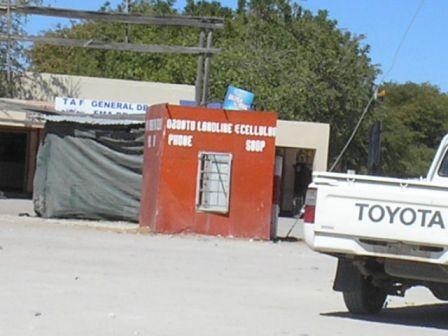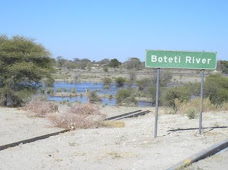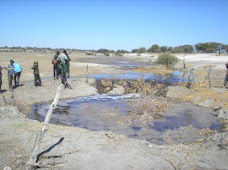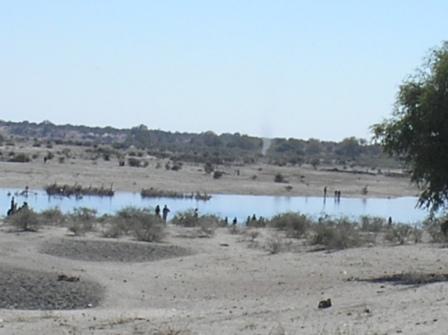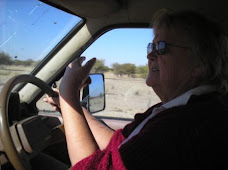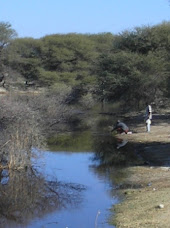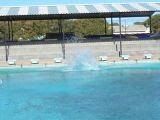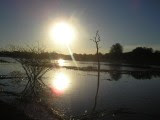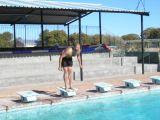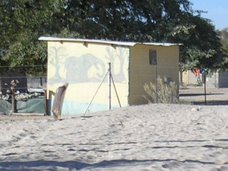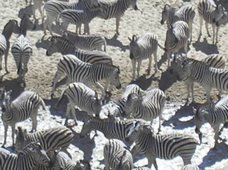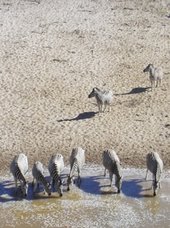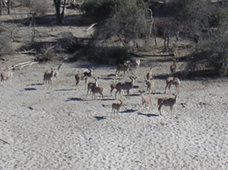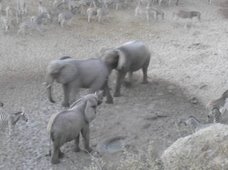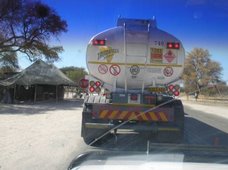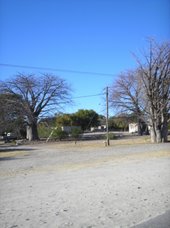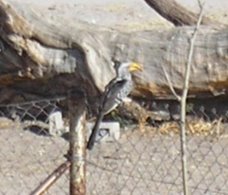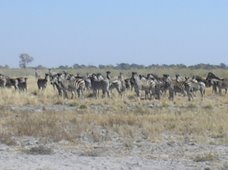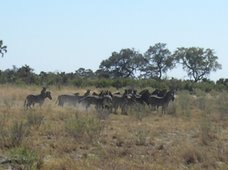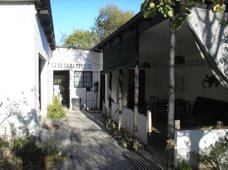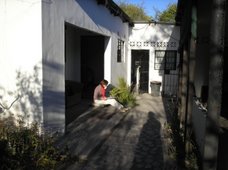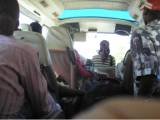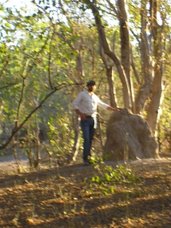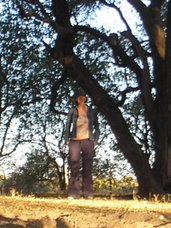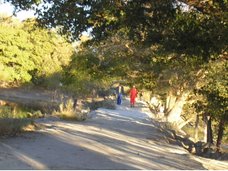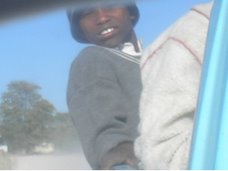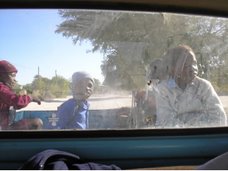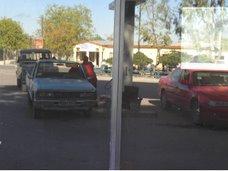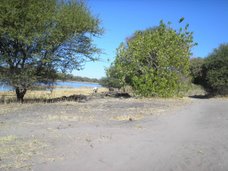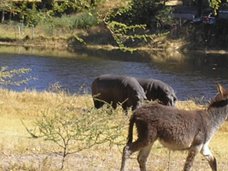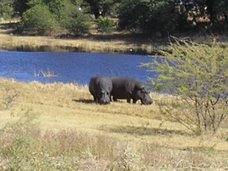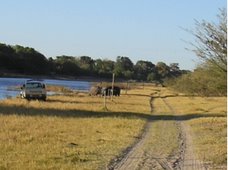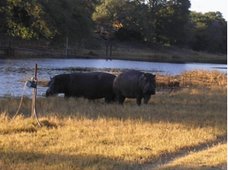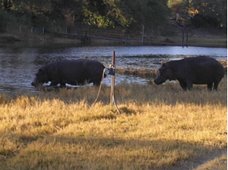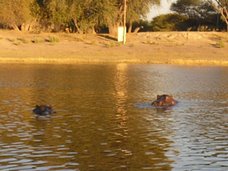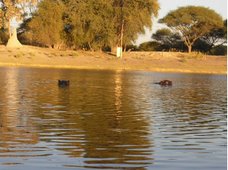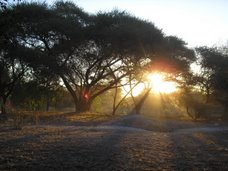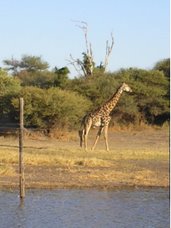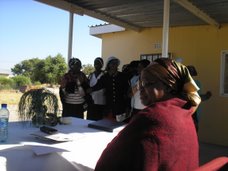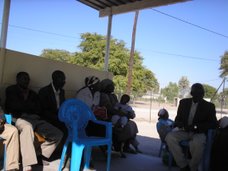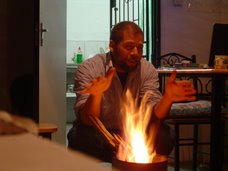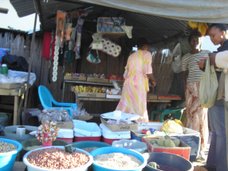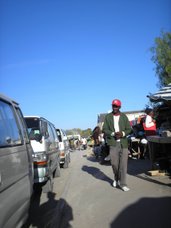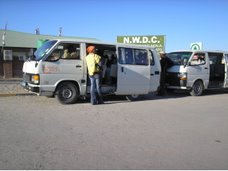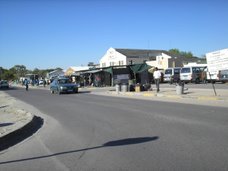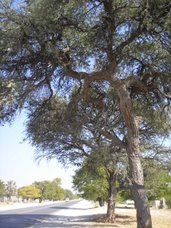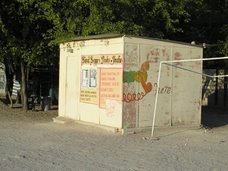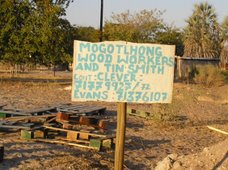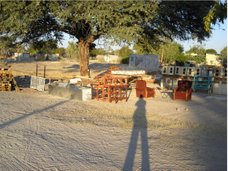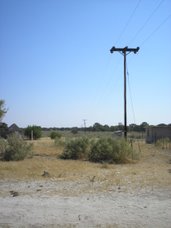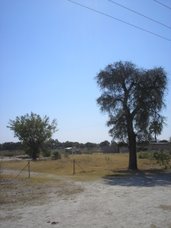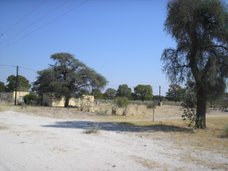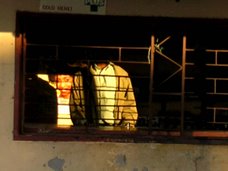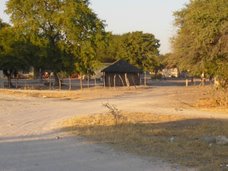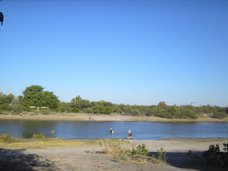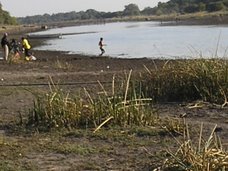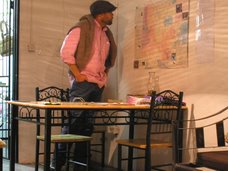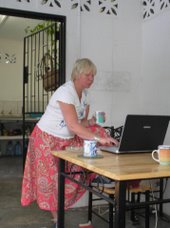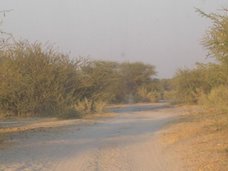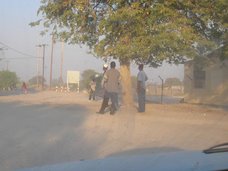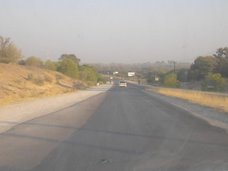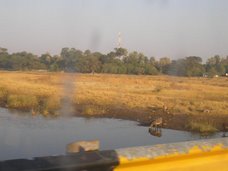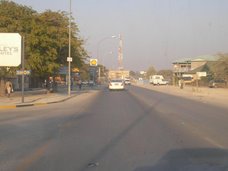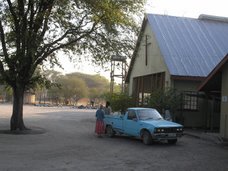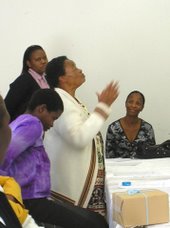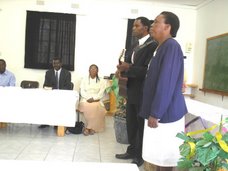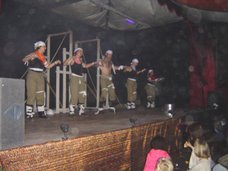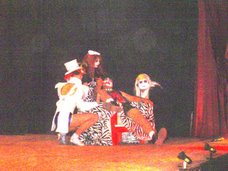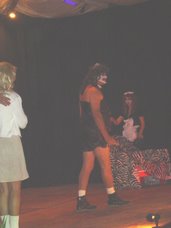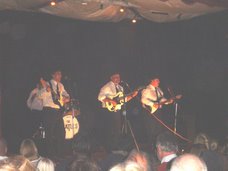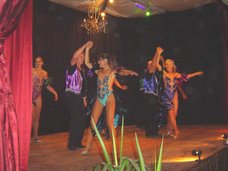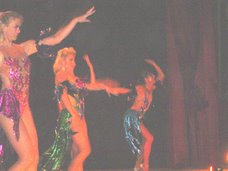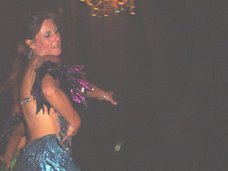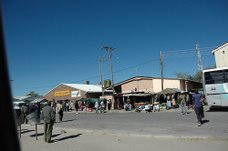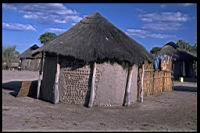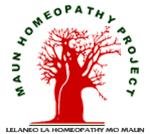Thursday, July 26, 2007
Three Patients Sitting In The Sun.
The patients’ strength makes their condition all the more poignant as we meet very strong people who are imprisoned in their own bodies through weakness. You can hear their strength in their voices, see it in their eyes or hear it in their words and it makes them appear in a very pitiful and tortured state as they cannot fend for themselves or engage with the world at large any more.
Seeing this strength although saddening to see imprisoned in a bed makes me optimistic that the patient will in time recover and this week I’ve seen this strength win through.
Today we were very happy to see three of our patients who were bedridden a week ago sitting outside in the sun. One was the albino patient I described in an earlier posting. Her first words when we met her were ‘I’m well!’. Her ulcers were clearly healing and she was very pleased to show us the progress they were making whereas at our previous visit shewas very weak and in a lot of pain and her ulcers were open wounds.
Our second patient had been in bed for months with diarrhoea and vomiting. Today she was sitting in her yard in the shade of a tree, proud to tell us that she could walk to her outhouse and back. Next time, she told us ‘You’ll see me cooking’.
Our third patient had also had constant diarrhoea which was now improved. Like the other patients she was sitting in her yard in the sun with her mother, her daughter and her grandchildren who were all playing at ‘foreigners in a decrepit pick-up stuck in the sand’.
I’m not describing people rising from the dead here. In all three cases there is a long way to go before they are as healthy as they’d like to be but the fact that they are out of bed, have more physical comfort and energy than before and doing things they enjoy is a big step for them on the road to recovery.
I’m pleased to say that many of the patients I am seeing now are improving or are returning to homoeopathy after a long time of being well. I’m not saying that this is all down to my sudden appearance on the scene. It is more due to the strength which the patients themselves posess and the many other homoeopaths who have added their skill to the proces of recovery.
The Flexibility of The Triad Method.
***The patient did well on their first and second prescriptions but they have returned. Their joint pains have returned but they find that they are now worse at the end of the day when they are at rest. They have to keep moving to keep the pains at bay. They began again around the time their children were threatened with expulsion from school because they were late with school fees (Everyone has to pay school fees in Botswana whether government or private school). The patient became worried for their children's future and took on extra work. Nothing much else worries them aside from their families welfare and their responsibilities.
In this case the aetiology of the joint pains and their characteristic of being worse for rest and better for continued motion indicates not Bryonia but Rhus Tox. The patients underlying constitution and background remain unchanged so far so the prescription can be repeated with the Bryonia, the initial remedy for the patients joint symptoms being changed for Rhus. Tox. Calc and Carc can be repeated as before.
More Medicine of Experience.
To make this easier I’ll give you an example of triad prescriptions for the sort of cases we often see. The cases given below are outline examples as a full case taking would be too much to present.
*** A patient has begun to get joint pains which are worse on motion and better for rest, these areaccompanied by a terrible headache which makes them just want to sit still and not be bothered by anybody. They naturally have become very bad tempered. Their focus in life is their home and family as they had to care for younger siblings and older relatives from an early age their parents died of cancer. They have recently had to cope with a bereavement and now care for another family members’ children. They take this responsibility very seriously. Their major worries are the pains which prevent them from working and this in turn makes them worry about how they will cope with their responsibilities.
After repertorisation the well indicated remedies include Bryonia, Cal.Carb. and Carcinosin. In this sort of case we would usually give each remedy one day apart in the appropriate potency for up 3 weeks Bryonia on Mondays, Calc. on Wednesdays and Carc. on Fridays.
Case 2
*** A patient is seen at home and they present with with diarrhoea accompanied by burning pains, respiratory difficulties, generalized physical pains at night and a very depresed state of mind. This has been continuing on and off for a long time but is now a chronic state and they are rapidly emaciating though they are trying to eat.
The well indicated remedies repertorise out as Ars. Alb.; Carbo.Veg.; and Syph.
As the condition is long standing and day by day worsens the patients health the remedies would be given over the course of a day in an appropriately low potency for a week.
In these hypothetical cases the patients show a good response at the follow up, they’re not completely cured but they’re much better than before.
So far so good. In these two cases the triad prescription has acted like a single remedy. There’s been a good reaction in the patient on all levels and the prescription can be repeated with confidence that it will continue the curative response in the patient.
The Dawning Of A New Era
We’re entering a new and exciting phase here in Maun. It is only one third as exciting now as it was a week or two ago but it is still exciting. Initially Anne and I were to be responsible for setting up a new clinic in Sehitwa, 90K southwest of Maun on the shores of Lake Ngami. We were also given responsibility for re-energising the poorly attended Senonori Support Group Clinic and of re-establishing our relationship with Bana Ba Letsatsi which means children of the street and as you can see from it’s name is a charity for streetchildren and children orphaned by HIV.
Sehitwa and Senonori unfortunately had to be put on the back burner because of logistical difficulties. As Sehitwa is 90k away we would have had to have used a vehicle other than our backie which is in pretty poor condition because it has to cope with some pretty rough terrain and is driven by several different people each year who each have to get used to an antiquated backie and very rough roads. This problem was almost solved by a member of the Lutheran Church’s congragation offering to loan us a vehicle for the journey. The only problem was, they wanted us to pay for mileage/wear and tear to the vehicle at 3 pula per kilometer in addition to us paying for petrol.
Then there was the question of which day we should go. We’d all agreed that once a month was a good routine for a one day clinic at the Lutheran Church in Sehitwa. For the Sehitwa group Thursdays was a god day. For MHP Mondays were preferable. Because there were too many if’s and but’s this project has to beleft until we get a new vehicle in September.
Senonori is another pickle. The time before last when we visited we saw only one patient. We had a chat with Rosinah the Senonori Support Group leader and she suggested that it was due to people’s fear of being stigmatised that they didn’t come to see us. We had another discussion with Rosinah this week and she told us the following story. As well as people in the area being worried about becoming stigmatised if they are seen visiting the homoeopathic clinic there is also a problem with the support group itself with whom we work. I can’t be quite sure of what it is despite having spoken to Rosinah who is Senonori support Group’s founder. It has something to do with it not being registered with the regional council department which looks after support groups despite SSG having applied for registration 3 years ago. Rosinah tells me that in addition to a lack of local government support and the fear of stigma of it’s members there is also now a suspicion in the community that Maun Homeopathy Project is something to do with the local council and we are checking up on them.
We’d arranged with Rosinah on several occasions to speak at local Kgotla meetings but due to one cause or another they’ve not happened. So, we are to continue turning up at Senonori but not to expect much to happen.
So, like I said, due to the Senonori and Sehitwa projects being put on the shelf things are only one third as exciting as they appeared to be. We do still have Bana Ba Letsatsi to look forward to which we will begin in August.
Tuesday, July 24, 2007
Homeopathy Research Institute
Homeopathy Research Institute
www.homeopathyresearchinstitute.org
PRESS RELEASE
(July 16TH 2007, London) The inaugural Board Meeting of the newly
formed Homeopathy Research Institute (HRI), took place in London in
June signalling a new era in the field of homeopathic research in the
UK.
The aim of the Homeopathy Research Institute is to promote and
facilitate high-quality scientific research in the field of homeopathy.
The HRI will be the first central resource dedicated solely to research
about homeopathy as it is practised today. A key task of the Institute
will be to communicate about the science relating to homeopathy to the
medical and scientific communities, the media, the general public, and
to homeopaths themselves. The Institute will form a bridge between the
scientific and homeopathic communities backed up by a strong PR and
communications team.
The Institute was founded by Dr. Alexander Tournier who holds a PhD in
Biophysics from the University of Heidelberg and is a fellow at Cancer
Research UK in addition to being a qualified homeopath. This background
places Dr. Tournier in the unusual position of being able to speak the
language of both academic science and homeopathy. He says, “Through
this institute, my aims are to strengthen the scientific foundations of
homeopathy, and promote homeopathy as a sound system of medicine
well-deserving of a place alongside conventional medicine."
The HRI’s Board of Directors consists of Dr. Tournier, Clare Relton
Msc, RSHom, (DH training fellow in CAM Health Services Research at the
University of Sheffield), Marcus Fernandez LCPH, MHMA, (homeopath and
vice-principal of the Centre for Homeopathic Education), and Dr. Nagin
Lad PhD, LCHE, (biochemist and homeopath). The Board is currently
supported by a team of consultants including Dr. Patti Bayliss, McHB,
FRCG, Sara Perkins Bran LCHE, (PR consultant and homeopath), and Dr.
Natasa Peric-Concha PhD , (molecular biologist and trainee homeopath).
At the inaugural Board Meeting, the participants established a
Scientific Committee in charge of developing the research program of
the Institute. The Scientific Committee is headed by Dr. Tournier along
with Clare Relton, and is presently composed of Dr. Lad and Dr.
Peric-Concha, Dr. Lionel R. Milgrom PhD, FRSC, RSHom, MARH, Dr. Mike
Emmans Dean PhD, MARH, Dr. Elizabeth Thompson MBBS, MRCP, FFHom, and
Prof. Kate Thomas among others.
Clare Relton, who is currently developing appropriate trial designs for
homeopathy research says, “I am very excited to be a part of the
Homeopathy Research Institute as it will pull together ongoing
homeopathy research and be a resource for new trials. Treatment
methods, homeopathic remedies and principles, cost effectiveness,
efficacy and safety are all areas the Institute will be examining.”
The Board also elected a PR Committee entrusted with developing the
communications strategy of the Institute. This consists of Marcus
Fernandez, Sara Perkins Bran and Natasa Peric-Concha.
The HRI invites participation from interested groups and individuals.
In particular, we would like to hear from people with fund-raising
expertise who are interested in consulting with our PR Committee. If
you would like to donate funds, find out more or help in some way,
please contact us.
Contacts:
Scientific Committee:
Dr Alexander Tournier PhD, LCHE
alextournier@homeopathyresearchinstitute.org
Phone 07843275751
PR Committee:
Sara Perkins Bran BA (Hons), LCHE
sara@imagohomeopathy.com
Phone: 020 8961 5948
Or visit www.homeopathyresearchinstitute.org
Sunday, July 15, 2007
The Medicine Of Experience
Seeing the patient
In this way have I come to understand the Triad Method we use to prescribe here. So, what happenned? Well, let’s look at it sequentially. Initially in the first two weeks of my stay hereI was looking at cases overJulia’s shoulder. It’s hard for me to get a real undertanding of a case from an observers position. It’s strange to imagine this but picture it. You’re in the same room as the patient and prescriber, not three feet away from them but the essential thing is, you are not face to face with the patient communicating with them directly. Sure, you have the time to read through their case notes and listenas the prescriber takes the case but you’ve not entered into a direct relationship with the patient.
The response to the remedy
The other problem was that many cases I saw befeore working solo were quite stuck. The patients had been neither getting worse nor appreciably better. They were generally long term patients and had a long history of remedies which had not moved them forward a great deal. So, you can understand, that when faced with this situation it is impossible to see how a patient has responded to a remedy and thus understand the prescription.
The development in my understanding of the Triad method came most importantly from working directly with patients. The first occasion was with an albino patient who has terrible ulcers on their skin. When we returned for a follow up we found them in a very weak condition. It appeared that they had become worse. One leg was swollen and had boken out in new eruptions.
Law of direction of cure
So how did this help to understand the Triad Method? The answer is careful case taking. We discovered that despite there not having been a general overall improvement her symptoms had shown movement in the direction of cure. Let me explain what this means. The Law of Direction Of Cure is probably better described as The Theory of Direction Of Cure as it can only be confirmed by repeated observations. Now, as each patient is an individual and will respond in different ways to the remedy the Law Of Direction Of Cure (LODC) cannot always be observed but it’s been observed often enough by homoeopaths that it has become an empirical guide to homoeopathic prognosis.
LODC states that illnesses is cured by the body healing itself from within to without. You can observe LODC operating in reverse during a cold. Usually the first symptoms to appear will be in the upper respiratory tract, the nose and throat. As the cold progresses it will begin to affect the lungs. This hypothetical cold will resolve under homoeopathic treatment according to LODC with the lungs being cleared first followed by the upper respiratory tract symptoms. Homoeopaths have seen this process at work in both chronic and acute illnesses. The law can be generalized to say that symptoms are observed to move from the centre of the body to the periphery; or from more vital organs to mucus surfaces or the skin.
In the case of the patient with the ulcerated skin we found, by careful case taking that although there appeared to be a worsening of symptoms (ulcers at a new site on the body and inflammation) they were moving from centre to periphery. During treatment the uklcers on the patients abdomen had cleared while new ones had appeared on their leg.
While the patients case remained serious from the perspective of pathology there was hope that their ulcers would heal as demonstrated by observation of LODC.
This demonstrated to me that the Triad Method of prescribing remedies worked and made it easier for me to accept it as a method to work with. At present I think that it would be impossible to say whether the patient responded to only one of the remedies or all of the remedies. For the sake of my peace of mind and to avoid expending valuable brain power on this question I rationalised that a triad prescription should be looked at as an often repeated single remedy. In application it is not this. Each remedy of the triad is taken sepparately but for the sake of case analysis it has to be seen as a single remedy to which the patient responds.
OK, so, I had seen a triad of remedies produce a favourable response in one patient. The next week I began practising solo. I was able to apply what I had learned under Julia’s close supervision to the cases which were returning to the clinics. My life as a prescriber was made much easier by the responses the patients had had on their remedies. Most of the patients I have seen since I began prsctising solo have been away from the clinics for up to a year because their last prescription produced such a favourable response.
Leaps in learning
How did this help me understand the Triad Method? Firstly seeing patients improve who are HIV positive and being treated with Anti Retroviral drugs (ARV’s) which can have some very debilitating side effects reinforced my acceptance of the Triad Method’s ability to work IN PRACTICE as opposed to theory; Secondly reading the patients notes, previous prescriptions and responses allowed me to understand further how triad prescriptions were formulated in response to which symptoms; Thirdly I was able to feel confident in my understanding of the case of each patient as they presented it to me and confident in my ability to respond with an appropriate triad of remedies.
I’ve been pleased to see that patients who I have prescribed for recently return with a good response to remedies which I have prescribed. This has really improved my confidence in using the Triad Method as I have begun to understand it by direct experience of working with it and seeing it work.
Monday, July 09, 2007
First let me begin with apologies to everyone reading this blog for my misinforming you on several occasions about the name of the river which runs through Maun. Be pleased to know that it is the Thamalakane river and shares it’s name with the Thamalakane fault line along which it flows in a roughly NE,SW direction. The Thamalakene is fed by three rivers the southern most of which is the Boro. These all flow out of the Okavango Delta. South of Maun the Thamalakane river divides into the Boteti and Nahabe Rivers. The Nahabe flows southwest towards Sehitwa and is joined by the Whanx river and they both flow into Lake Ngami with Sehitwa on it’s shores.
Julia will be having her own very special wildlife experience. Julia has been spirited away to the ‘camps’ where she will be treating camp staff with homoeopathy. The camps belong to a group called Sanctuary and their personell officer, Mary, has been liaissing with Solly the MD of Itekanele health insurance to get us up to the camps. This is great news for the Maun Homoeopathy Project as it means the charity will be paid a monthly retainer to treat the staff at Sanctuary Safari Camps whether they tutn up for treatment or not. It’s good for us homoeopaths too as it means we each get a trip out to these places toeards the end of our terms in Botswana.
I’ve really been enjoying the wildlife here. Once again I must apologise for misnaming a Lilac Breasted Roller as a Lilac Breasted Rocker. Easy mistake to make. I was also lucky enough to see a Raquet Tailed Roller on the road up from the Thamalakane River just before the turn off for Francistown. So, my wildlife log so far, in chronological order is…Goats, Brahmin Cattle, Donkeys, Horses, Pied Kingfishers, Girraffes, Zebras, Warthogs, Wildebeest, Impala (not Kudu as I have probably misinformed you before), Hippopotami, Fish Eagles, Sacred Ibis, Lilac Breasted Roller, Blue Waxbills, Yellowbilled & Bradfields Hornbills, Hammerkop, Bearded Woodpecker, Yellowbilled & Yellowbilled Oxpecker, Hoopoe, Grey Lourie.
I can also identify a Mopane tree. Anne and I are determined not to be left out of the wildlife experience stakes. Last night 07/07/07 we went for a walk to the Old Wooden Bridge which crosses the river just before Old Bridge. This is a good long walk. If you begin on the southern Disaneg bank you have an interesting walk as there are now about 3 new makorro ferries to tak you across. They were not there when I made my first walk in this direction about a week ago. Now the river is much higher and is beginning to eat into the vehicle track which runs towards Maun town.
If uou begin on the disaneng bank you meet, after about half an hours walking fences and bushes which mark the bopundaries of someone’sland. These are impassable and meen that you have to turn south towards the new road which is being built through disanengand loop round the fenced in land. Once you have found your way back through the sage brush ( for that is what it is, many many yellow green sage bushes interspersed with Mopane trees and others) around the houses and down to theriverbank you continue along in the gentle evening sun. Eventually the bank in front of you curves west and appears to meet the northern Sedia bank. This feels a bit disorienting the first time you do it as it feels as if you have simply walked along the banks of a canal. If you follow the bank round and double back on yourself you realize thet you have followed a U shape down one arrm, along the base and up the other. So, now you’re standing at the top of the right arm of the U. The river flows down past this arm and you can now see the Sedia bank clearly and tou realize that you are still on the Disaneng bank.
Up river about 100 yards away is the ould wooden bridge which is a very beautiful spot. It is constructed from concrete and treetrunks laid over short sections of concrete pipe through which the river flows and it’s pillars are large live trees which povide an avenue of welcome shade to anyone crossing the bridge. If you cross the bridge from Disaneng bank towards the Sedia road bank you can walk back along this bank by walking along a road through a neighbourhood and then turning left down the alley between two compounds back onto the riverbank.
Walking the river along the Sedia road bank is muchquicker than on the Disaneng bank as one does not need to curve away from it at any point, nor negotiate small game trails gthrough thorny bushes. However, last night Anneand I decided to walk towards the bridge along this route and back along the Disaneng bank towards home.
We walked some of the way to the bridge along the Disaneng bank because we wanted to cross to the Sedia side by one of the other Makorro ferries. Captain Small Makorro is very very busy al day it appears. About 100 yerds up is Mma Makorro, so called because it is run by a venerable old lady further on there is Rootsy Makorro, so called because it is a fibreglass boat but in the shape of a traditionl wooden makorro and has no seats. Like Captain Small Makorro and Small Boy Makorro, Rootsy Makorro is punted back and forth by a small boy who pole vaults onto shore from the back of the boat to haul the boat in. After Rootsy Makorro is Small Boy Makorro and then Cattle Makorro. There is also Bridge Makorro at the bridge.
We chose Rootsy Makorro because he doesn't’t seem to get half as much trade as Captain Small Makorro. Also Mma Makorro was not around. But in future I think we will stick with rootsy. We passed small-boy-Makorro and Cattle Makorro and walked along the vehicle tracks in the sage brush. We were passed by a man teaching his son to ride his bike. The man had a broom jammed down through the forks behind the saddle down to that bit where the pedals are attached and was jogging along acting as a sort of stabiliser. They also had 3 dogs with them. Two spaniel type things and one Boer Bull type dog. All 3 were chasing birds. The Boer Bull actually ran into the river and began swimming in pursuit of a bird on the wing (a type of shrike, I think) which led him mid-stream before turning and flying back to land.
Anne and I saw some good birdlife on the way. We saw our old friend the Roller who is very timid and who only lets you get so close before flying away in a streak of electric blue. We saw a Pied kingfisher fishing and a Hammerkop dabbling. We arrived at the Old Wooden Bridge very late in the afternoon but a beautiful saffron light wast stil shafting through the trees on the Sedia bank. The Old Wooden Bridge always has a very good atmosphere and especially so on a Saturday evening. When I first came up that way I walked past the campsite and met the owner a jolly old Batswana man who told me about his camp and his orchard and how difficult things were for growing crops as Botswana’s rains hadn’t been so good that year.
Anne and I crossed the bridge and decided against followingthe river towards Old Road Bridge and Hippo Pool as it was getting late. If we didn’t want to walk back in the dark we should turn back now. We walked along the spur of land which forms the right arm of the U and into the real forest that covers it. Works of art was part of the that days themes of conversation. One of our conversations touched on Skrimshaw. We’d been approached by an artist outside the Okavango pharmacy the other day selling carved and skrimshawed keyrings which looked suspiciously like ivory. Thankfully Anne has a lot of experience of bones through her work as an archaeologist andwas able to assure us that it was bone.
Now, I’ve been really interested in Skrimshaw ever since my dad brought me home a walrus tusk with an original skrimshaw commemoratingthe victory of the US frigate ‘Constitution’ oover the British manned, captured French ship Guerrier. And I’ve always been up for the opportunity for working in that medium. So one of the things we wereon thelookout for were bones. You can often find Cattle bones a and pieces of mangled goat strewn along the river bank. We found a nice small fragment of femur and as we walked around the promontary found a great cows tibia, nice andfresh. Unfortunately we had to leave it as it was very bigand we had nothing to carry it home in so I will make do with practisingon this nice smooth, shiny piece of femur.
So, like I said, walking back along the Disaneng bank means having to negotiate a loop behind the compounds which run up to the waters edge and a couple of meandering paths through thorny bushes. It is not the quick way home. It does however have the advantage of being the riverbank on which we live so we don’t have to worry about whether we’ll be in time to catch the last makorro across the river.
We picked up the pace as the light began to fade. This is the time of day the riverbank becomes more dangerous as it becomes the haunt of hippos who tend to charge firstand ask questions later. I was feeling confident that we would see any hippo’s before they saw us and also I knew the way home so I was feeling fairly chirpy by comparison to Anne. Now, Anne is no wet behind the ears hobby homoeopath, oh no. I told you before she was an archaeologist and as such she earned her stripes roughing it with the roughest of them in Cyprus, Israel and merrie England. And grew up in Dublin and Birmingham, and Nannied with the best of them in Islington. Anne’s no softie but the prospect of meeting a hippo by surprise was a prospect of no joyous portent.
So as we trecked on and the conversation turned to how we could make the best out5 of an encounter with hippos. I reminded Anne that hippo’s have a big turning circle and so all we would need to do is double back, then again as it was so dark, nipping behind a bush would be a good option as well as doubling back. I was also pretty sure that the hippo’s would spot me better as I was wearing lighter clothes so I could run while Anne nipped behind a bush and then I could double back.
I don’t think these suggestions did much for ither of our confidences but it passed the time. That is until the bats came out. Anne is no fan of bats. But soon and sure enough we reached the path to our back gate and breathed a sigh of relief to be home, safe from marauding hippos and swooping bats. I cooked a light and celebratory cheese omlettes for us both. I had been planning to manage to make the omlette I made for myself as good as the one I made for Anne. Until that evening, if I had ever cooked omlettes for us all I had succeded in slightly overdoing the outside of mine.
Things were going well the eggs beaten with a spoonful of yoghurt were coalescing and turning a pleasing shade of yellow. I swirled the pan and sent the surplus out to the edges thus evening up the depth of the omlette. As I made the salad I paid attention to the pan, now on a low heat until the edges of the omlet began to twitch free of the pan. I picked up the pan and gave it a shake and the omlette slid smoothly. I had decided that I would seal the inside briefly sendit back over and then add the feta cheese.
I flipped the omlette like those wafer perfect pancakes which added extra relish to Chris Coombes and Claire’s party in the Barbican. Down it came, pan perfect and sizzled with the air of a cat which has found a warm and welcoming lap. I jiggled the omlette again. The inside was sealed just nicely, up and over and add the feta. But it was not to be. Oh no. I wasn’t going to be the man who would be eating an omlette just as good as his pal’s that night. Up went the omlette, down campe the omlette only to catch its edge on the pan and come a very nasty cropper.
Polly helped me tidy the kitchen by eating 1/5 of my omlette off the kitchen floor and Anne made me feel a lot better by giving me a little piece of her omlette which was a beauty if I do say so myself. Altogtether, that day a splendid time was had by all.
Wildlife Park
As if we hadn’t had enough. Today (08/07/07) Anne and I drove over to the wildlife park.. This is a fenced off area of bush. You can see the fences from town extending half way into the river and you can walk up to them from our place which gives you an Idea of how big it is.
I think today our mission was really to scout the place out and generally see what we could see. We walked in a straight line pretty much for 2 hours through sage brush and forest and down to the rivers edge. We had some good encounters along the way. First things we saw were squirrels. Then – Wow, excuse this interuption readers but I have just heard a hippo grunt close by. I have heard them in the afternoon on days when I have seen them on the bank but never so late at night and never, apparently so close to the compound. A hippo grunt sounds like a pig grunt about fivetimes in quick succession, grunt-grunt-grunt-grunt-grunt. But of course you can tell that it comes from a larger and more cavernous beastie.
So, next in the wildlifw park we saw pretty warthogs rooting and down at the rivers edge very timid ground hornbills and a fisheagle carrying lunch home in its talons. Also a bearded woodpecker diligently knock-knock-knocking for grubs and really ignoring us until I thought I’d try to take his photo when he became suddenly alert and went to find a more peaceful tree.
Then, through the trees an ubiquitous sage brush we saw a new russet brown, more vital than the grey looking tree trunks. It was an Impala. Chosing separate paths and moving as slowly and quietly as we could we moved towards them. They had seen us a long time before we had seen them and they transformed themselves into a blur of brown and white and were away. We followed in the direction they had taken, slowly and quietly hoping to glimpse them as they paused.
They are very beautiful creatrues to watch moving, they appear not to touch the ground as they leap away into the shadows. One moment there are three Impala in a clearing standing still and you can feel 6 black eyes watching the way you move. Suddenly the leader will give a snort like a starting gun and many more bodies than you had seen will flach through the dappled shade each one different in size and shape but all part of a stream of energetic beauty.
The wildebeest are much harder to see as they are as grey as the shade and the tree trunks but we made one or two out as the Impala flew noislessly past them, the impala’s golden bodies throwing the grey of the Wildebeest into silhouette.
Finally we saw Zebra in groups of three. The Zebra were far less timid than the Impala and far slower moving. One of the group would stand their ground as we approached, face on to us and twitching it’s top lip over it’s teeth. They’re great little horses, if indeed they are horses. Are Zebras horses? A crate of Maun’s finest Champagne to anyone who can tell me! Whatever speicies Zebras belong to they are very good to look at. They are well rounded in a baroque way and move with an indescribable (for me anyway) dignity. I’m so glad I have had the chance to see these animalsup close and in their natural habitat.
We didn’t see the Giraffes which I think are the prize. It would be an amazing experience to be able to walk as close as one could to these animals. I was thinking about the Giraffe recently. They are built along the lines of prehistoric animals yet they really are beautiful and that, I think is what stops them looking so obviously strange. Their beauty takes your mind off their weird shape.
Also, a box of Maun cigars to anyone who can tell me whether there is an Aesop’s fable or Just So Story to explain why chocolate is poisonous to dogs.
Monday, July 02, 2007
Trouble With Triad
In the 6 months before I left for Botswana I’d been familiarising myself with Eizayager’s layers method and so when I was introduced to the Triad Method at my induction for the project it sounded like a reasonable way of going about things. In theory, that is.
In practice it is a lot different. You’ll see in the last post I added (below this one) I’ve given myself a few criteria to use to help me prescribe using the Triad Method, and I’ll use the method because I agreed to do so. Thus, it is possible to rationalise to oneself how to use the triad method. The most difficult thing I am finding in practice at the moment is working out which part of the prescription has worked.
My understanding of the practice of homoeopathy is that you don’t prescribe for separate parts of the case and this is what it feels like is being done here at the project. Having said that, I would feel more at ease with this prescribing method if we were prescribing only two remedies, one for the appropriate totality of symptoms and one nosode. The third remedy seems to me to be superfluous and I feel I’m prescribing it simply to cover bases. This is a scary thing to admit as people are coming to us for help and will surely expect us to know what we are doing.
The other source of confusion about this method is having a remedy for the ‘acute layer’. So far noone I have seen has presented with acute symptoms, either an acute exacerbation of a chronic condition or an opportunistic infection, acute miasm, etc. etc. so merely the name of this layer causes me confusion too.
As I’m sure you can see, I’m pretty confused about this but trying to deal with the confusion by using reflective practice and supervision. It helps me to think things through by writing them down and hopefully by the time I’m further through my stay here I’ll have resolved my questions about the method. I also hope that what I write is being read by other homoeopaths and I’m able to share my experience with them.
The major headache for me at present, after having taken the case and found a third remedy which I feel I can justify within the case is which part of the previous prescription has worked. Patrly this is due to summary sheets only having recently been introduced. 99% of cases have to be read through before the consultations and the key points of the case drawn together while doing this. This is quite a task as the notes are handwritten by several successive homoeopaths. You’ll see throughout the histories that some prescriptions work very well and the next prescription is changed for no apparent reason. Why? I think part of this is due to different practitioners from different backgrounds seeing different things in a case and responding the best way they can see. Another reasonn seems to be practitioners departing from the protocols that have been set by the project. Yet, I still ask myself, why wasn’t the last prescription which brought about a positive change for the patient repeated?
I’ll keep you all posted about how my understanding of the method and it’s application develops. I’m sure all the homoeopaths have been dying for me to actually get on to the subject of actually prescribing etc. The Triad Method is a little bit of a problem for me from the point of view of homoeopathic philosophy and here’s why. I’m classically trained so the basic prescribing method I am familiar with is one appropriate remedy, watch and wait. Whether prescribing for an acute or chronic case. Then repeat or change the remedy according to the response.
In the 6 months before I left for Botswana I’d been familiarising myself with Eizayager’s layers method and so when I was introduced to the Triad Method at my induction for the project it sounded like a reasonable way of going about things. In theory, that is.
In practice it is a lot different. You’ll see in the last post I added (below this one) I’ve given myself a few criteria to use to help me prescribe using the Triad Method, and I’ll use the method because I agreed to do so. Thus, it is possible to rationalise to oneself how to use the triad method. The most difficult thing I am finding in practice at the moment is working out which part of the prescription has worked.
My understanding of the practice of homoeopathy is that you don’t prescribe for separate parts of the case and this is what it feels like is being done here at the project. Having said that, I would feel more at ease with this prescribing method if we were prescribing only two remedies, one for the appropriate totality of symptoms and one nosode. The third remedy seems to me to be superfluous and I feel I’m prescribing it simply to cover bases. This is a scary thing to admit as people are coming to us for help and will surely expect us to know what we are doing.
The other source of confusion about this method is having a remedy for the ‘acute layer’. So far noone I have seen has presented with acute symptoms, either an acute exacerbation of a chronic condition or an opportunistic infection, acute miasm, etc. etc. so merely the name of this layer causes me confusion too.
As I’m sure you can see, I’m pretty confused about this but trying to deal with the confusion by using reflective practice and supervision. It helps me to think things through by writing them down and hopefully by the time I’m further through my stay here I’ll have resolved my questions about the method. I also hope that what I write is being read by other homoeopaths and I’m able to share my experience with them.
The major headache for me at present, after having taken the case and found a third remedy which I feel I can justify within the case is which part of the previous prescription has worked. Patrly this is due to summary sheets only having recently been introduced. 99% of cases have to be read through before the consultations and the key points of the case drawn together while doing this. This is quite a task as the notes are handwritten by several successive homoeopaths. You’ll see throughout the histories that some prescriptions work very well and the next prescription is changed for no apparent reason. Why? I think part of this is due to different practitioners from different backgrounds seeing different things in a case and responding the best way they can see. Another reasonn seems to be practitioners departing from the protocols that have been set by the project. Yet, I still ask myself, why wasn’t the last prescription which brought about a positive change for the patient repeated?
I’ll keep you all posted about how my understanding of the method and it’s application develops. I’m sure all the homoeopaths have been dying for me to actually get on to the subject of actually prescribing etc.
So, when the working day is done we get a good opportunity to relax and re-energise like good, hard thinking, hard working, reflective homoeopaths should.
